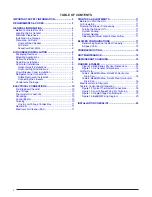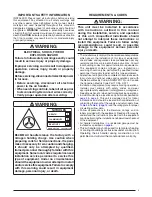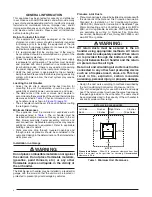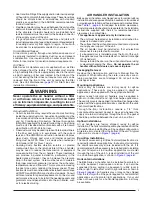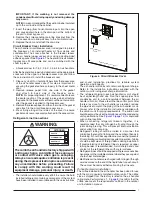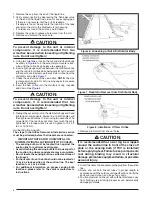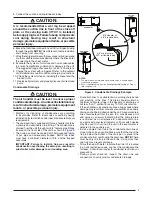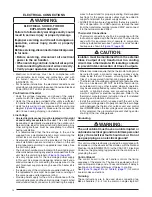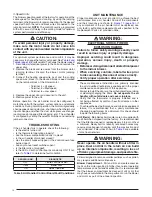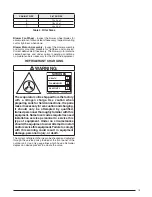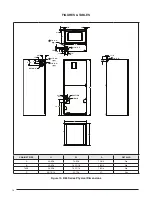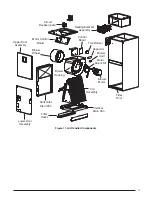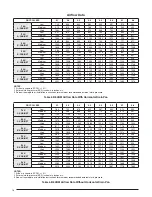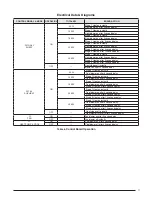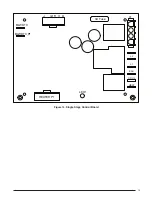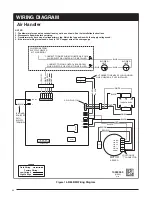
7
IMPORTANT: If the webbing is not removed, the
condensate will not drain properly and ceiling damage
may occur.
NOTE:
It is recommended that the suction line be insulated
up to the coil inside of the cabinet.
7. Insert the plug (from horizontal drain pan) into the open
and unused drain hole in the drain pan at the bottom of
the unit to block bypass air.
8. Remove the corresponding drain line knockout from the
coil access door to allow access to the horizontal drain.
9. Replace the door and attach the drain line.
Circuit Breaker Cover Installation
The air handler circuit breaker cover is designed to protect
the breakers of an installed heater kit from debris and
condensation.The cover attaches to the breaker recess
of the air handler upper access door using a double-sided
. The heater kit circuit breaker
toggles are still accessible and can be switched with the
cover in place.
• 2-breaker cover for 1.5, 2, 2.5, 3, 3.5 & 4 ton air handlers.
After the heater kit is properly installed, remove the appropriate
knockouts in the upper air handler access door and follow
these instructions to install the breaker cover:
1. Clean any oil, dirt, or insulation fibers from the recess area
of the air handler access door. This step is important for
ensuring the gasket adheres properly to the sheet metal
door.
2. Remove release paper from one side of the gasket
and attach to back side of the breaker cover.
NOTE:
For proper alignment, It is recommended to leave
the center section of the gasket in place when attaching
the gasket to the breaker cover. Remove the center section
after the gasket is applied to the breaker cover.
3. Remove the release paper from the other side of the gasket
and attach to the circuit breaker recess area.
4. Press firmly along all four sides of the cover to ensure
gasket and cover are securely attached to the access door.
Refrigerant Line Connections
WARNING:
NITROGEN
HEALTH
FLAMMABILITY
REACTIVITY
0 Minimal Hazard
1 Slight Hazard
1
0
0
The coil in the air handler is factory shipped with
a nitrogen charge. Avoid direct face exposure
or contact with valve when gas is escaping.
Always ensure adequate ventilation is present
during the depressurization process. Address
any uncertainties before proceeding. Failure
to comply with this warning could result in
equipment damage, personal injury, or death.
• The installer should make every effort to ensure the field
installed refrigerant containing components of the system
have been installed in accordance with these instructions
and sound installation practices for reliable system
operation and longevity.
• The air handler coil does not contain a refrigerant charge.
Refer to the installation instructions supplied with the
outdoor unit for refrigerant charge information.
• The refrigerant piping to each air handler (or coil) should
be of equal length and size. Run the copper pipes from
condensing unit to a point equidistant between the air
handlers (or coils). Place a tee in the lines at this point. After
the tee (as close to the air handler as practical), reduce
the pipe size to match the piping of the air handler or coil.
• Always refer to the installation instructions supplied with
the outdoor unit for piping requirements. The suction and
liquid lines must be sized in accordance with the condensing
unit specifications. See
for liquid and
suction line locations.
• When connecting refrigerant linesets together, it is
recommended that dry nitrogen be flowing through the
joints during brazing. This will prevent internal oxidation
and scaling from occurring.
• Refrigerant tubing should be routed in a manner that
minimizes the length of tubing and the number of bends in
the tubing. It should be supported in a manner that prevents
it from vibrating or abrading during system operation. Tubing
should be kept clean of foreign debris during installation.
• If precise forming of refrigerant lines is required, a copper
tubing bender is recommended. Avoid sharp bends and
contact of the refrigerant lines with metal surfaces.
• Refrigerant lines should be wrapped with pressure sensitive
neoprene or other suitable material where they pass against
sharp sheet metal edges.
• B64 Series air handlers are charged (with nitrogen) through
service valves on the end of the liquid tube for each circuit.
These must be removed before brazing the line sets.
Orifice Removal & Installation
The orifice installed in the air handler has been sized for use
with the most popularly matched outdoor units. The orifice
size as shipped from the factory is listed on the air handler
rating plate. Perform steps 1 - 9 (
) to confirm that the
orifice size meets the requirements outlined in the outdoor
unit installation manual.
Circuit Breaker
Cover
Circuit
Breakers
Recess
Air Handler A
ccess Door
Figure 5.
Circuit Breaker Cover


